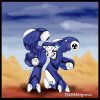Psychie
Princess Psychie
All equipment and mecha will be posted here.
Follow along with the video below to see how to install our site as a web app on your home screen.

Note: This feature currently requires accessing the site using the built-in Safari browser.




 One of the most unique Cyclone designs ever constructed, the VR-015 in Cycle mode, at.first glance looks very similar to the Rifleman, except that it appears to have a double-wheel configuration with two tires side-by-side in the front and back. It isn't until the wheels split and the motorcycle becomes a hovercycle or flying Battloid that the true reason for its design is seen. .
One of the most unique Cyclone designs ever constructed, the VR-015 in Cycle mode, at.first glance looks very similar to the Rifleman, except that it appears to have a double-wheel configuration with two tires side-by-side in the front and back. It isn't until the wheels split and the motorcycle becomes a hovercycle or flying Battloid that the true reason for its design is seen. . Model Type: VR-021 Nova Space Cyclone.
Model Type: VR-021 Nova Space Cyclone. VR--024 Comet Space Cyclone Veritech
VR--024 Comet Space Cyclone Veritech
















